
Tin ore is one of the important strategic mineral resources. Tin and tin alloys have been widely used in modern national defense, industry, cutting-edge science and technology and human life.
At present, the common tin ore processing processes mainly include gravity separation, flotation and magnetic separation, that is, the raw ore is washed and deslimed, crushed and screened, pre-selected, and then processed by one or more classification equipment such as gravity separators, flotation cells, magnetic separators, etc., and finally obtain the ideal grade and recovery of tin concentrate. Below, we will mainly explain to you the different tin ore processing processes and equipment used.
At present, most tin concentrates are produced from cassiterite deposits, and the density of cassiterite is greater than that of intergrowth minerals. Therefore, gravity separation has become one of the main beneficiation processes for tin ore and is often used to separate alluvial tin. The gravity separation of cassiterite is generally ore classification. The gravity separation of cassiterite is generally ore classification. Generally, the process of a multi-stage grinding and multi-stage separation is adopted, which can realize the principle of early dissociation, early recovery and early discarding, and avoid unevenly embedded cassiterite causing excessive crushing.
Since cassiterite produces slurry during the crushing and grinding stage, classification and desliming is a relatively important preparation operation before cassiterite gravity separation. While removing the slurry interference, it can also control the selected particle size and generally adopts the ore washer, cross-flow belt chute and small-bore cyclone as the desilting equipment. The gravity separation equipment commonly used in tin ore mainly includes jigs and shaking tables.
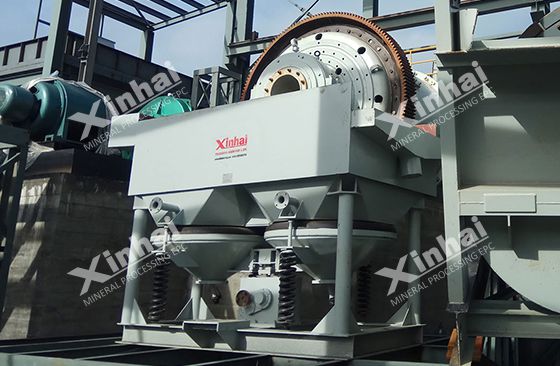
The jig makes different proportions of mineral particles mixed and stratifies them proportionally in a vertically moving variable-speed medium flow. The minerals with a small proportion are located in the upper layer, and the minerals with a large proportion are located in the lower layer. Then the layered materials are discharged separately using the action of machinery and water flow.
For alluvial tin with a high degree of monomer dissociation, it only needs to go through simple screening to screen out the large pieces of non-tin barren rock, and then gravity separation by the jig to obtain a good sand tin ore processing index. The jig is especially suitable for the classification of coarse mineral particles (except for micro-fine materials of any size of mineral materials). For alluvial tin processing, the lower limit particle size can be up to 0.04mm when the specific gravity difference≥1.25 and the ore monomer is dissociated. The process operation is simple, the selected particle size is large, the selected range of particle size is wide, the equipment processing capacity is large, and the application effect is very good in the alluvial tin with high monomer dissociation.
Shaking table is a tin ore processing equipment in the horizontal medium flow, mainly using the transmission mechanism to drive the table to make a longitudinal reciprocating motion, make the rush flow and table surface differential motion. In the reciprocating motion, the ore particles are subjected to the layering effect perpendicular to the bed surface and the separation effect parallel to the bed surface, so that materials with different particle sizes are discharged from different zones of the bed surface to realize classification.
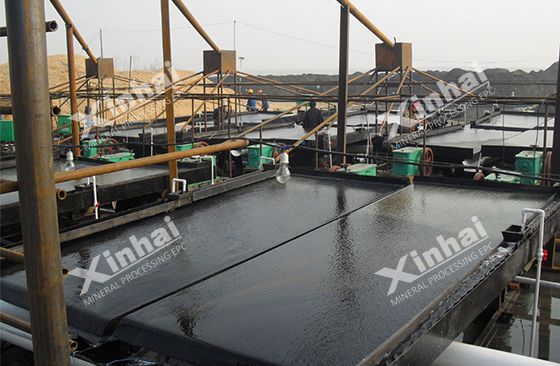
For alluvial tin with a low monomer dissociation degree, it is difficult to obtain the ideal concentrate grade and processing recovery rate using a simple screening-gravity separation process. Generally, a multi-stage grinding - multi-stage gravity separation process is required to improve the processing index. Firstly, the large pieces of barren rock are screened out by screening, and then separated by gravity with the jig to obtain a gravity-selected coarse concentrate to be ground by the rod mill and break the conjoined structure and then separated by gravity with the jig. Since some of the over-ground tin ore cannot be fully recovered in the jig during the rod milling process, gravity separation by shaking table is required for the tailings from the second-stage jig. In the gravity separation equipment, the shaking table is particularly suitable for processing minerals with finer particle size, so it can be used to recover the fine cassiterite present in the tailings, thereby increasing the recovery rate.
Due to the low separation efficiency of cassiterite gravity separation for tin minerals with a particle size of less than 19μm, flotation separation has become one of the important ways to recover fine-grained tin minerals. However, the fine-grained flotation separation of cassiterite also has a large surface area and large consumption of reagent and other issues. At present, there are two methods to improve the flotation effect of cassiterite fine particles: one is to pre-process fine tin minerals before flotation; the other is to use an effective combination of flotation reagents and equipment.
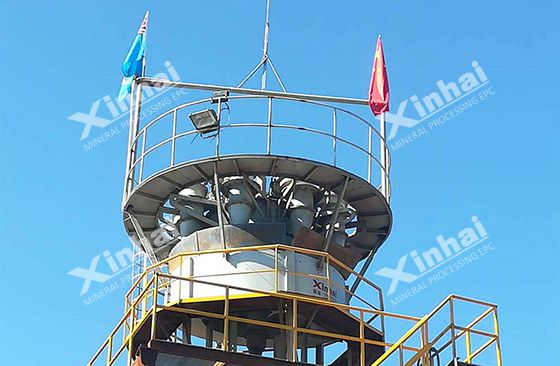
Common pre-processing methods include strong agitation of the slurry, large-diameter hydrocyclone classification, small diameter hydrocyclone desliming, lowering the lower limit of classification size and lower limit of desliming size and so on.

Common collectors for cassiterite flotation include fatty acid collectors, alkyl sulfonated succinic acid collectors, phosphonic acid, and arsine acid. Sodium silicate and sodium carbonate, sodium hydroxide is often used as pH adjusting reagent in cassiterite flotation. Sodium silicate has an inhibitory effect on cassiterite, calcite, scheelite, quartz, feldspar and other minerals, but its inhibitory effect on various minerals varies according to the dosage, and generally, the concentrate grade and enrichment obtained at pH 10 is better, and generally the concentrate grade and enrichment obtained at pH 10 is better. Sodium hexametaphosphate is used to inhibit calcite, limonite and other minerals in cassiterite flotation, and can be used with oleic acid. Sodium fluorosilicate is a commonly used medium regulator in the flotation of cassiterite fine slurry. It can be used with sodium alkyl sulfate and styrene phosphonic acid to expand the flotation area and facilitate the flotation of cassiterite, and can also be used as an inhibitor of vein minerals to improve the concentrate grade. Carboxymethyl cellulose is also a commonly used calcite inhibitor. In addition to the above adjusting reagents, common reagents for cassiterite flotation also include hydrogen sulfide, sodium sulfide, naphthol sulfur, low molecular oxalic acid, citric acid, lactic acid, tartaric acid, etc.
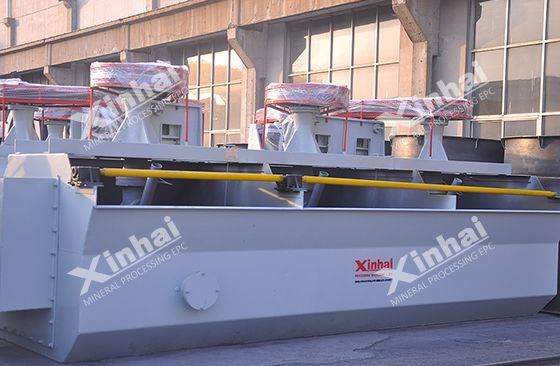
The tin ore processing equipment used in this process includes various types of suction mechanical agitation flotation cells (SF flotation cell, BF flotation cell, JJF flotation cell) and inflatable mechanical agitation flotation machines (KYF flotation cell, XCF flotation cell).
It is worth noting that due to the problems of large surface area and large consumption of agents in the tin fine particles flotation, we can pre-process the fine-grained tin minerals before flotation or use an effective combination of flotation chemicals and equipment to improve the cassiterite fine-grained flotation effect method.
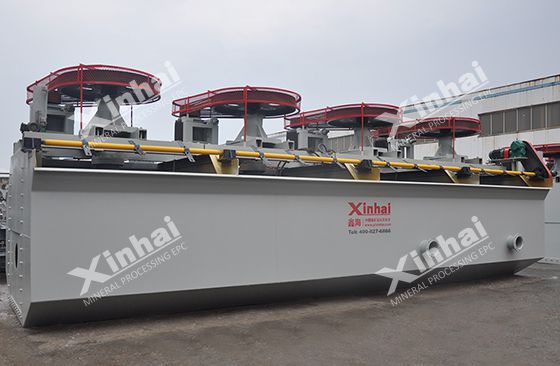
Therefore, before choosing the tin ore flotation cells, the tin processing plants can consider choosing a combined unit consisting of KYF flotation cell and XCF flotation cell. XCF is used as a suction tank and KYF is used as a DC tank to achieve horizontal configuration without the need for a froth pump; the U-shaped tank makes the flotation distance as short as possible, the slurry flows to the bottom of the tank, and the rotor is pumped to the gap between the impeller and the stator, which is conducive to the return of coarse and heavy ore particles to the impeller area for recirculation, avoiding the accumulation of ore sand and reducing the short-circuit phenomenon of the slurry. The combined unit composed of KYF flotation cell and XCF flotation cell greatly reduces equipment management and maintenance operations, reduces system energy consumption and investment costs, and significantly improves the efficiency of fine-grained tin processing.
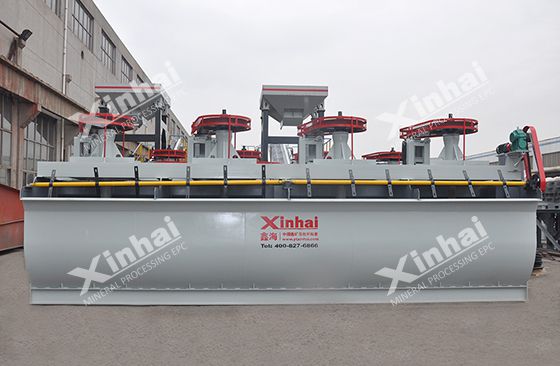
Since some tin ores often contain various iron oxide minerals (such as magnetite, hematite and limonite, etc.), tungsten ore and other co-occurring minerals, such minerals cannot be well separated from cassiterite by flotation and gravity separation methods. Therefore, magnetic separation is often used in the washing process to achieve tin-iron separation. Wet strong magnetic separation is the main method of magnetic separation, used for raw ore, secondary concentrate and concentrate before entering gravity separation, while the dry magnetic separation process is often used to separate tungsten minerals and tin minerals. Commonly used magnetic separation equipment includes wet magnetic separator and dry magnetic separator.
Wet magnetic separator
The wet magnetic separator is a wet permanent magnetic separator widely used in the separation of strong magnetic minerals. According to different applications and classification conditions, each series of wet magnetic separators has a different magnetic system design and tank structure. The wet magnetic separator has a large wrap angle magnetic system, which can increase the length of the separation belt and the number of magnetic flips to realize the efficient separation of magnetic minerals and non-(weak) magnetic minerals.
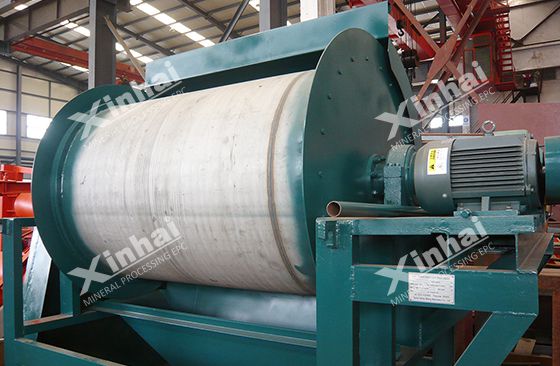
For tin ore magnetic separation, wet magnetic separators are mainly used in three aspects: raw ore magnetic separation, secondary concentrate magnetic separation, and concentrate magnetic separation.
(1)Raw ore magnetic separation:
After preparation, the raw ore is processed by magnetic separation before entering the classification operation. The non-magnetic part and the magnetic part obtained enter the separation process separately. Among them, the non-magnetic part is easier to process and can obtain higher recovery and concentrate grade, while the magnetic part is more difficult to classify and mostly produces rich-medium ore or even poor-medium ore.
(2)Secondary concentrate magnetic separation:
As mentioned above, the secondary concentrate contains more iron minerals, and the separation of tin and iron can be effectively achieved by magnetic separation.
(3)Concentrate magnetic separation:
The above two aspects of magnetic separation often require cassiterite and iron minerals to be separated as much as possible, but this contradicts the purpose of reducing the excessive crushing of cassiterite. After the iron mineral enters the concentrate as a combination, it can be more fully ground, while effectively avoiding the phenomenon of cassiterite over crushing.
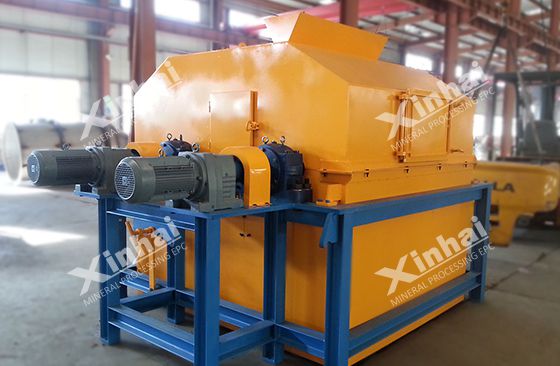
Dry magnetic separator
The dry magnetic separator adopts a 360° magnetic wrap angle design. The magnets all adopt NdFeB magnets with high magnetic energy product and high coercivity, which have high magnetic field strength and large depth of action, and can make the minerals flip and stir quickly, so as to realize the efficient separation of magnetic minerals and non-(weak) magnetic minerals with small mineral loss rate.
For tin processing, dry magnetic separator is commonly used to separate tungsten which is symbiotic with tin. The main minerals of tungsten and tin have high densities. The coarse concentrate generally contains wolframite, scheelite and cassiterite.
Dry strong magnetic separator can separate wolframite, cassiterite and scheelite in coarse-grained materials and then separate cassiterite and scheelite by electric separation.
In the actual processing process, tin processing process and equipment selection are often based on the property of tin, plant conditions, investment budget and other factors to determine. To process tin ore more economically and environmentally, it’s better to conduct a processing test to analyze comprehensively the property of ore. Scientific processing test reports are obtained to determine which tin ore processing processes and the specific type and model of tin ore processing equipment can be used to achieve the desired return on investment.
To find out more about our products and solutions, please fill out the form below and one of our experts will get back to you shortly.